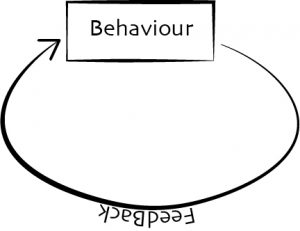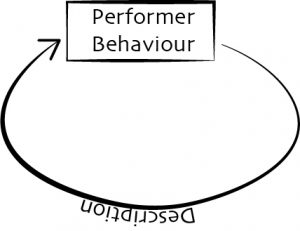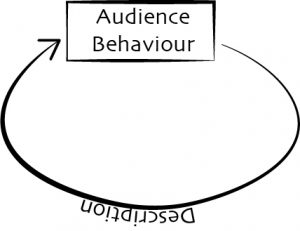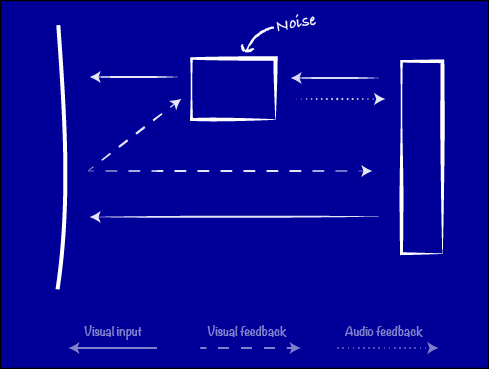Look into the Camera
When looking into Graham’s performance, one of the points that surprise me is how little technology is used in it. Essentially, the mirror is the only technological device used in the performance.
I understand the mirror as technological device in the sense that it is a human-produced artefact intended to help us to perceive reality.
Following this idea, a modern technological device that comes to mind is a (video) camera. However, this brings the concerns expressed by Flusser on how the use of television image. In Flusser’s perspective, through the use of television image the world has a scientific character where events not longer take place but they become staged happenings. In that sense they are then repeatable.
Event
Not repeatable [get def]
Happening
Repeatable [get def]
I this light, I wonder: to what extent was Graham’s original work an event or a happening? How will bringing a camera into the context change this? And does this matter?
For this, I started to look into one particular scene to focus my analysis of the reenactment.
Scene 3
I decided to focus on scene 3: The performer faces the mirror (his back being turned to the audience). For about 5 minutes, he continuously describes his front body’s gestures and the attitudes it may signify. He is free to move about, to change his distance relative to the mirror in order to better see aspects of his body’s movements. When he sees and describes his body from the front, the audience, inversely, sees his back (and their front). The performer is facing the same direction as the audience, seeing the same mirror-view. The audience can not see (the position of) the performer’s eyes.
What most intrigues me in this scene is the self-reference issues it brings into the picture. The performer describes his own behaviour. But, how is this really possible? Is the behaviour leading the description or is the description leading the behaviour? In other words, what was first, the description or the behaviour?
This in itself rises the question of the temporality on the performance. In what time could this performance take place? At a first glance, it should be the present. However, there are two elements in the performance: the performer and the audience. In the original performance we could first argue that the timeline is the same for both. However, the description of a behaviour, as seen in the performance, is a description of an event in the past. The description in itself then modifies the future behaviour of the performer. Moreover, in scene 4, we see that the description given by the performer actually influences the behaviour of the audience. This reveals to me that the principles of cybernetic systems are hiding behind Graham’s performance.
Cybernetics

The basic principle of feedback in cybernetic systems
Performer

The principle of feedback in cybernetic systems in a scene 3
Audience

The principle of feedback in cybernetic systems in a scene 4
Then my first exploration is the following: how can a camera be used to enhance this manipulation in the performance in order the divorce the timelines of the audience and the performer.
Deconstructions I

Orginal performance
Here I start deconstructing Graham’s work under the light of cybernetic systems. With this perspective, we see that the original work has two systems: the performer and the audience. We then have the following feedback loops, which are enabled or disabled depending on the scene: both systems provide visual input to the mirror and both get visual feedback from it. The audience provides visual input to the performer and the performer provides audio feedback to the audience. In this composition noise is introduced by the performer. He does this either by changing his position towards the audience, facing them or the mirror, or by providing them with audio feedback on their behaviour.
How will this change once a camera is introduced?

Introducing a camera
One of the first changes a camera brings is that it is only an input device. Hence, it we will need another component for the output. A first idea is to introduce a screen where the input of the camera is projected. This will then provide visual feedback to both the audience and the performer.
This implies that there is a flow of information between the camera and the screen. This opens possibilities to introduce noise into the visual feedback loop. How this can be used to influence the behaviours of both audience and performer is something to consider. Following the thought of descriptions referring to an event in the past, we could consider introducing a delay in the output. In the particular case of scene 3, this might be too obvious. In fact, as we can see in videos with delay it may even be annoying. However, in another type of scene, like scene 4, this could be more interesting. The audience could then ask: How long ago did the events that the performer is describing take place? What is the temporality of this performance?
Another point to notice in this setup is that the camera concentrates the visual input for both the audience and the performer. But then, why should this be the case? We can use many cameras for this. It is even more interesting to consider the spatial dimension: why do performer and audience have to be in the same room?
